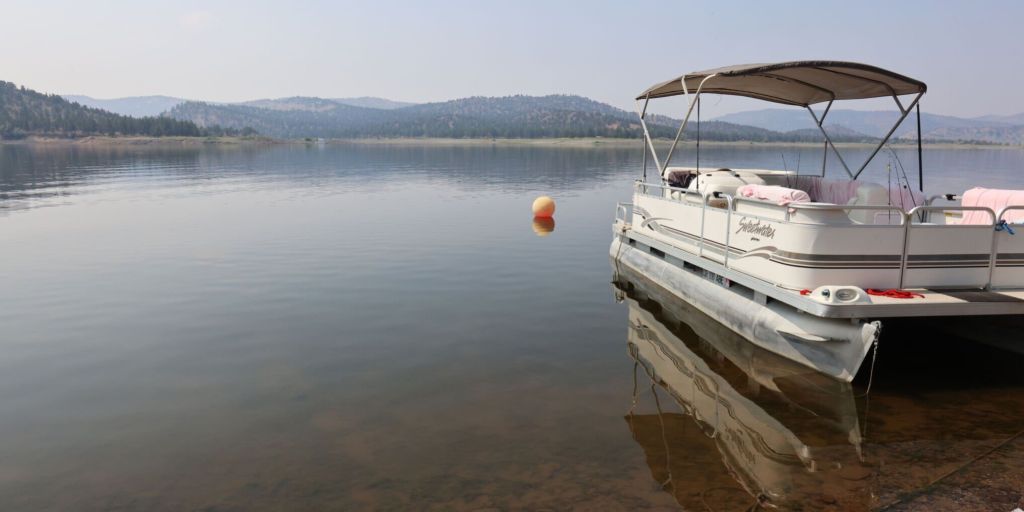Higher reservoirs helping Central Oregon irrigation districts navigate drought
Published 5:00 am Monday, August 28, 2023

- Water levels are up, allowing good boating conditions at Prineville Reservoir on Wednesday.
Tight water allotments across Central Oregon have helped irrigation districts stretch the growing season even as drought continues to remain a problem in the region.
Trending
Wickiup Reservoir is 73% higher compared to a year ago and Prineville Reservoir is a whopping 366% higher, according to data published on the Bureau of Reclamation website.
The higher water levels in area reservoirs give hope to farmers and ranchers that most districts will have water until the end of the irrigation season, which typically runs until mid to late October. Recent years have seen districts cut off water in midseason, complicating plans to prepare fields for the following year.
The increased water level at Wickiup is mainly due to reduced water use by irrigation districts with senior water rights, said Jeremy Giffin, the Deschutes Basin watermaster.
Trending
“They have been very aggressive this year in conserving water, and that is why we have that extra water in Wickiup,” said Giffin. “We were pleasantly surprised.”
Prineville Reservoir has been rescued this year by significant snowpack in the Ochoco National Forest last winter. Snowmelt in the Ochocos reaches reservoirs more quickly than in the Eastern Cascades because the area is less volcanic and less reliant on springs.
Saving water for a dry day
Irrigation districts have had to be stingy with their water. All of Central Oregon remains in some form of drought, ranging from moderate to severe.
Craig Horrell, general manager for Central Oregon Irrigation District, the region’s largest district in terms of patron numbers, said his district has responded to the shortages by cutting water by 40% this year.
Arnold Irrigation District had its season extended compared to a year ago because of the improvements in water savings. Last year, the district shut down on July 23. This year the district initially shut down on July 30 but was able to turn water back on the following week after a basin storage report showed more water was available. Now Arnold is scheduled to be turned off on Sunday.
After a promising spring, drought again stalking Central Oregon farmers
“Their account will be dwindling down to near nothing,” said Giffin.
Schedules thrown off
Unfortunately for Arnold Irrigation District patrons, the unpredictable water situation made farming a challenge because of the complexities of growing crops.
Ethan O’Brien, co-owner of North 44 Farms, said he plans his seeding and harvests around the expected water delivery window information provided by the irrigation district. When water delivery schedules change, it’s usually too late to start planting fresh seeds.
“If we had known we would have an extra month and a half of water in early July, we would have re-seeded our fields and essentially doubled our hay production,” said O’Brien. “Instead, the hay fields have been left fallow and we have been over-irrigating our pastures, just to use the water somewhat beneficially.”
Other districts are reporting slightly improved conditions compared to a year ago.
In the North Unit Irrigation District, patrons are receiving less than half of their normal allotment, but almost double what they were getting a year ago. Tumalo Irrigation District has been rotating water deliveries, with seven days on and seven days off to conserve water. The district plans to shut off for the season on Sept. 8.
Water for the frog
It is not clear yet how much water will be left in Wickiup at the end of the season. The U.S. Fish and Wildlife Service has rights to some of the water and could use it to slow the ramp-down period at Wickiup Reservoir to protect spotted frog habitat.
“They are going to use that extra frog water to slow the ramp down so it’s really easy on the frog,” said Giffin.
Jodie Delavan, a spokesperson for U.S. Fish and Wildlife, said the agency is working with the irrigation districts on a schedule to release water conserved through conservation projects “so it will further enhance Oregon spotted frog habitat as irrigation releases slow down for the season.”
Cate Havstad-Casad, a farmer in the North Unit Irrigation District, said this year has been more predictable compared to previous years, and she is pleased that the season has not been disrupted by midseason water cuts. She has also adjusted to the limited water supplies by planting more grains instead of vegetables because they require more water.
“I’ve learned our profession requires massive adaptability to climate, to water allotments, to the pandemic, you name it,” said Havstad-Casad. The farm she co-owns with her husband Chris Casad — Casad Family Farms — grows organic grains and hay that they feed to their livestock.
“I still hope for more equitable distribution of water in this basin and better definitions of beneficial use in the long term, but I’m glad we have pivoted to keep our operations going through such drastic change,” she said.
Wickiup: 24% full
Prineville Reservoir: 72% full
Crescent Lake: 10% full
Haystack Reservoir: 83% full
Ochoco Reservoir: 41% full









